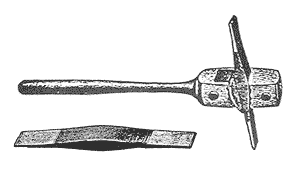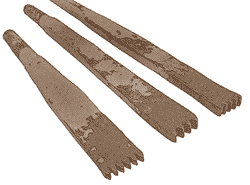 | ||||
home / about the artist / stoneboat series / lipwork series / metaphorical presences / landscapes / multi-element installation pieces / recent works
technical processes / thumbnail galleries / Cortona foundry / Finland stone carving / recommended reading / all in the family / links page
www.dondougan.com
DON DOUGAN
SPECIAL PURPOSE TOOLS
TRADITIONAL PROCESSES
PAGE STILL UNDER CONSTRUCTION
IN THE GROOVE
CUT AND CLEFT
 | ||||
 | ||||

The Mill Pick or Mill Bill had a removable blade and was used to dress the grooves in millstones.
In use the Mill Bill was held and worked like a Pick, although unlike the common Pick only one of the two cutting edges (the upper one in this image) can be used when the blade is fitted to the handle.
The image above (taken from an old tool catalog) is misleading in that the tool showing the blade in the handle is upside-down. If the lower cutting edge of the tool as pictured was struck against the millstone, the blade and the wedge that holds it in place would loosen and fall out.
 | ||||
 | ||||
 | ||||
All tools for working stone might be considered a special purpose tool, though from the point of view of the sculptor or stone carver the perhaps examples on this page might be considered specialized to an even greater degree.
There is a certain expected variety to the design of stone-working tools that corresponds to the specific stone-working trades that put them to use. The design for many types of trade-specific tools are simply modified from the general type of stone working tool. In this way the Crandall can be seen as a very specific type of Bush Hammer, and in this instance it is easy to see the direct relationship of the specific type to the general type.
However, some specialized tools are so uniquely suited to performing a single task that their resemblance to the general type is less obvious, whether in form or function.
Though few of the tools on this page will ever be encountered except perhaps in a museum or from a tool dealer unique to a particular trade, they are included to illustrate the principles underlying the functions determining their form.
Understanding how these tools function cannot but help the carver/sculptor to better know how to work their own expressions into the material, or to suggest an aspect of the process to further explore.
The blade is fitted to the handle off the perpendicular by approximately 10-degrees or so, to allow the user to work into the groove and thus remove the waste towards their body. This position affords the user both a direct line-of-vision for the area being worked and the greatest degree of control over the tool. A good comparision would be the manner of using the common Garden Hoe to work a furrow in the ground.

 | ||||

A tool used to work
another type of
groove is called the
Channeller.
Though the Channeller appears to be a Toothed Chisel that needs sharpening, in function it is not used like one, but instead used more in the manner of a Bush Chisel.
To remove a deep recess in the surface of a carving, first a row of holes are drilled to a set depth around the perimeter. The Channeller — or its shorter cousin the Ripper — is used to crush and break away the waste between the holes.

The ridged 'teeth' and slight flaring of the cutting end prevent the tool from wedging into the channel being cut as a common sharp-toothed chisel would tend to do.